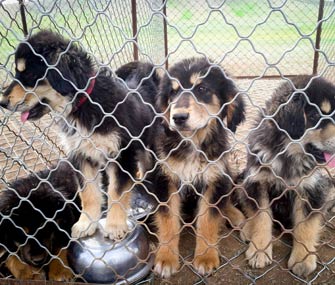The Return of the Bankhar: An Ancient Mongolian Herding Dog Gets a Second Chance
Published on August 08, 2016

As far as the eye can see, flocks of goats, sheep and other livestock dot the vast steppes and deserts of Mongolia, a country twice the size of Texas. With 75 percent of its land serving as pasture, herding has traditionally been the backbone of the Mongolian economy and the 52 million livestock outnumber the country’s 3 million people.
Nomadic herders tend the animals, but it’s not always easy to keep track of them on fenceless plains that are also home to predators such as wolves and the endangered snow leopard. Herders respect the predators but need to protect their flocks as well.
“One herder in the Gobi said he lost 70 animals in a year,” says Greg Goodfellow, a scientist who works with the Mongolian Bankhar Dog Project (MBDP). “That’s a lot to lose.” In an effort to stop such large-scale losses, the MBDP is bringing back the Bankhar, an ancient Mongolian herding dog.
“The Bankhar were traditionally and historically used here in Mongolia in this role, and that practice has died out,” Goodfellow says. “We’re trying to bring them back by working with herders throughout the country.”
Bankhar fell out of use as herding dogs in the 20th century, as shepherds turned to more lethal techniques, such as trapping and poisoning, to deter predators.
The Mongolian Bankhar Dog Project
In 2004, Bruce Elfström, an American entrepreneur with a background in biology, was in Mongolia working on an IMAX film. Elfström found himself wondering why herders didn’t use livestock guardian dogs, which he had seen in other countries.
Elfström talked with herders and learned that in some remote areas of the country, shepherds were still using Bankhars, traditional Mongolian herding dogs, to protect their flocks. He began to think about how reviving the breed could help herders. In 2011, he founded the MBDP to put his ideas into action.
The Bankhar is a large, powerful dog with genes that go back thousands of years, based on DNA studies. They are Mastiff-type dogs, distantly related to Tibetan Mastiffs. Bankhar appear laid-back while overseeing their flocks but are highly alert and move with agility and speed if danger threatens.
Bankhars are considered to be a landrace rather than a pedigreed breed. A landrace is a domesticated regional variation developed over time through adaptation to a particular natural and cultural environment. That means that the Bankhar’s traits were formed more by the harsh environment and isolated nomadic lifestyle of the Mongolian pastures than by human manipulation. Landrace dogs tend to have a uniform appearance but are typically more genetically diverse than dogs bred to a formal breed standard.
Traditionally, the Bankhar is black with orange spots above the eyes. According to Mongolian folklore, the spots permit the dogs to see into the spirit world. The dogs may also be golden-brown, white or black with a silver or white patch on the chest. White Bankhar are uncommon — Goodfellow says he has never seen one.
At maturity, the dogs stand 26 to 33 inches tall and weigh 80 to 125 pounds.

Putting Bankhars Back in the Fields
The hope is that the Bankhar will offer herders an alternative means of protecting their flocks without harming already endangered predators. "We are giving herders dogs that provide them with a non-lethal alternative for protecting their herds," says Goodfellow. "Otherwise herders will hunt and trap these predators, exacerbating the other human activities that are threatening snow leopards."
The dogs are bred at an MBDP facility located about 100 kilometers west of Ulaanbaatar. Pups are raised with sheep from birth, and when they are 2 to 5 months old, they are placed with nomadic herders who learn how to train them to stay with the flock. Currently, the organization has placed about 20 puppies and dogs with various herders in three locations: Gorkhi-Terelj National Park, Hustai National Park and South Gobi.
“Our idea is that the dog will be almost like a coworker for the herder,” Goodfellow says. “Some of the herders have confirmed that one Bankhar can protect about 50 livestock animals." The MBDP’s goal, he says, is to provide each herder who works with the project with enough dogs to guard an entire flock.
So will the Bankhar make the jump to the U.S. as a pet any time soon? Not likely, Goodfellow says with a laugh. People who tried to keep a Bankhar in a typical suburban home would soon find it destroyed.
“I would feel bad for the person who didn’t know what they were getting into if they got one and tried to keep him indoors or even in a big yard,” Goodfellow says. “They dig all the time. They’re very active and would be a handful for sure.”
For now, the Bankhar will stay in Mongolia — and that’s just fine with Goodfellow. “It’s cool to work with a dog that’s so ingrained in the history and culture here.”
More on Vetstreet:
- 5 Dog Breeds You’ve Never Heard of
- 10 of the Coolest Dog Parks Across the US
- 8 Rare Dog Breeds That Are Immigrating to America
- Purebred Vs. Mixed Breed: A Vet Weighs In
- 8 Dog Breeds That Have Held Cool Jobs





